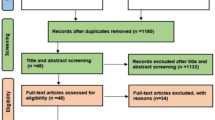Abstract
The study investigated the variables that predispose adolescents to drop out of school. The sample for the study was made up of 350 participants drawn from the adolescent school dropouts in Edo Central Senatorial District of Edo State of Nigeria. From the analysis of data, it was found that the following factors predispose students to drop out of schools: financial, home, societal values and personal characteristics of the adolescents. However, peer influence and school factors were found not to predispose adolescents to drop out.
Similar content being viewed by others
References
Adedeji, A. (1985). Child study in educational practice. Lagos, Nigeria: Macmillan.
Akinboye, J. O. (1981). Guidance and counseling strategies for handling adolescents and youth problems. Ibadan, Nigeria University Press Limited.
Aluede, O.O. (1999a). Peer influence on human learning. In E.T. Ehiametalor & R.O. Osagie (Eds.) Fundamentals of human learning (pp 133-143). Benin-city, Nigeria: Nigerian Educational Research Association.
Aluede, O.O. (1999b). Influence of the home. In E.T. Ehiametalor & R.O. Osagie (Eds.) Fundamentals of human learning (pp 122-132). Benin-city, Nigeria: Nigerian Educational Research Association.
Aluede, O.O. & Ikechukwu, B.N. (in press). School counsellor's roles in minimizing adolescents' attrition from schools. Orientacion y Sociedad, 3.
Animba, O. (1993). Campus secret cults. In O. Animba, D. Denga & P.F. Omoluabi (Eds.), An appraisal of student unrest in Nigeria (pp 90-107). Enugu, Nigeria: ABIC Books & Equip Ltd.
Ansere, J. K. (1982). The relevance of distant education to socio–economic development in adult education in Nigeria. Ibadan, Nigeria: Afrograka Publishers.
Cervantees, L. (1965). The dropout: Cause and cure. Ann Arbor, MI: University of Michigan Press.
Elliot, D.S. & Voss, H. L. (1974). Delinquency and dropout. Washington, DC: DC Health.
Fafunso, O. A. (1994). A study of educational needs of street children and youths in Osodi-Isolo local government area of Lagos state. Unpublished M. Ed dissertation, University of Lagos, Lagos, Nigeria.
Garnie, H. E. (1997). The process of dropping out of high school: 19 years perspective. American Educational Research Journal, 34, 393-419
George, A. (1997, March). Effects of access to counseling and family background on at-risk students. Paper presented at the annual meeting of American Research Association, Chicago, USA.
Helge, D. (1993). Problem and strategies regarding America's migrant student dropout rates. Journal of Human Services in Rural Environment, 17(2), 22-26.
Izundun, N.T.A. (1991). Contemporary issues that bother on Nigerian adolescents and youths: implications for counseling. In G.C. Unachukwu & G.C. Igborgbor (Eds.), Guidance and counselling: A realistic approach (pp 310-325). Owerri, Nigeria: International University Press.
Kaplan, D. S., Peck, B. M. & Kaplan, H. B. (1997). Decomposing the academic failure dropout relationship: A longitudinal analysis. The Journal of Educational Research, 90, 331-43.
Karl, A. L, Entwiste, D. B. & Horse, C.S. (1997). From first grade forward: Early foundations of high school dropout. Journal Sociology of Education, 70, 87-107.
Keith, P. B. & Schartzer, C. L. (1995, August). What is the influence of Mexican American parental involvement on school attendance patterns? Paper presented at the American Psychological Association, New York, USA.
Linqren, G. & Henry, C. (1976). Educational psychology in the classroom. New York: John Wiley and sons Inc.
Mackey, J. (1977). Strategies for reducing adolescent alienation. Educational Leadership, 34, 449-542.
Mora, M. (1997). Attendance, schooling quality and demand for education of Mexican, African-Americans and non-Hispanic Whites. Journal of Economics of Education Review, 16, 408-418.
Musgrave, P. W. (1972). The sociology of Education. London: Methuen and Company Ltd.
Nwagwu, C.C. (1991). Transition from primary to junior and senior secondary schools: A critical analysis of the implementation experience. In E.T. Ehiametalor, M.A. Izuagie & S.O. Olaitan (Eds.), Implementation of the national policy of Education (pp 12-24) Benin City, Nigeria: Nigerian Educational Research Association.
Okedara, J. (1986). An appraisal of the mass literacy programme in 1982/83 session. Lagos, Nigeria: Federal Ministry of Education.
Omorogbe, S.K. (1994). Attitude, information and change. In G.B. Efoghe (Ed.), Self and Others: A social Psychological approach (pp 133-144) Agbor, Nigeria: Pon Publishers.
Onwueme, M.S. & Ugbor, U. (1994) Education and society: The sociology of Education. Benin City, Nigeria: Nigerian Educational Research Association.
Robb, M.E. (1995) Engage: A career development based learning to learning programme for youth, parents and teachers. Washington D.C: Office of Educational Research and Improvement.
Santrock, S.W. (1981) Adolescence: An introduction. USA: WMC Brown Publishers.
Shaffer, D.R. (1989) Development psychology: Childhood and adolescence: (2nd Edition). California: Brooks/Cole Publishing Company.
Sheet, R.H., Izard, B.G & Alterbery, P (1997) Bridge: A Programme designed to ease the transition from the middle level to high school. NASSP Bulletin, 81, 93-99.
Sherif, M. & Sheriff, C.W (1964). A study of adolescence groups. New York: Harper and Row.
Sprinthall, N.A. & Collins, W.A. (1984). Adolescent psychology: A developmental view. New York: Random House, Inc.
Thomas, S.J. (1977) Increasing instructor and student communication through dropout notice surveys. Los Angeles, CA: Harbour Coll. Wilmington Office of research and development.
Trusty, J. (1996). Counseling for dropout prevention: Applications from multi cultural counseling. Journal of Multicultural Counseling and Development. 24, 105-117.
Vander Zanden, J.W. (1980). Educational psychology in theory and practice. New York: Random House Inc.
Volkman, B. (1996). You cannot educate an empty chair: Increasing student attendance through parents' involvement in regular classroom lessons. Unpublished manuscript University of Mississippi, USA.
Author information
Authors and Affiliations
Rights and permissions
About this article
Cite this article
Aluede, O., Ikechukwu, B.N. Analysis of the Variables That Predispose Adolescents to Dropout of Schools. International Journal for the Advancement of Counselling 25, 181–192 (2003). https://doi.org/10.1023/A:1026284329850
Issue Date:
DOI: https://doi.org/10.1023/A:1026284329850




